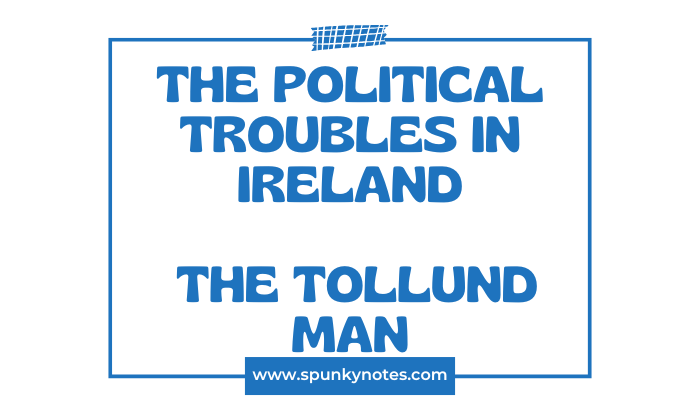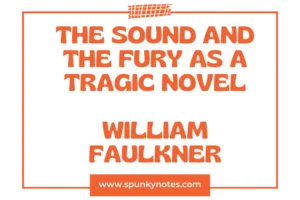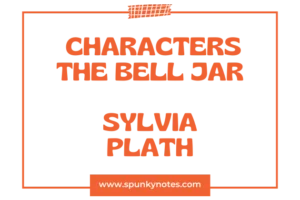
Q. How Seamus Heaney Connects the Tollund Man to the Political Troubles and Martyrs in Ireland in The Tollund Man.
The Political Troubles in Ireland in The Tollund Man
Seamus Heaney’s poem The Tollund Man connects the ancient sacrifice of the Tollund Man to the political troubles in Ireland. The poem links the past and present, showing how violence and death have shaped both history and modern life.
Heaney compares the Tollund Man, a victim of ritual sacrifice in Denmark, to the Irish people who died during the conflict in Northern Ireland. He sees a connection between ancient sacrifices and the killings of political martyrs.
Heaney also draws connections to earlier Irish conflicts, including the Easter Rising of 1916, in which Irish nationalists fought for independence from British rule. He presents these deaths as part of a long cycle of violence in Ireland.
The poem suggests that Ireland is trapped in a cycle of violence, where people continue to die for political and religious causes.
Violence in Ireland
During the late 20th century, Ireland experienced violent conflicts known as The Troubles. This was a period of tension between Catholic nationalists, who wanted Ireland to be united, and Protestant unionists, who wanted Northern Ireland to remain part of the United Kingdom.
Many people were killed, including innocent civilians and political activists. Some were seen as martyrs who died for their beliefs.
Heaney connects this modern violence to the ancient sacrifice of the Tollund Man. The Tollund Man was killed as an offering to the gods, and his community believed his death was necessary.
Similarly, in Ireland, people were killed because of political and religious divisions. The poem questions whether such deaths are ever justified.
Heaney writes:
Consecrate the cauldron bog
Our holy ground and pray
Him to make germinate.
Here, Heaney suggests that the bog where the Tollund Man was buried could be seen as sacred. He compares it to Ireland, where people have died for political causes.
Martyrs in Ireland
In Ireland, many people who were killed during The Troubles were viewed as martyrs. Some were fighters who died for their cause, while others were civilians caught in the violence.
Just as the Tollund Man was sacrificed for the good of his people, Irish martyrs were seen as sacrifices for their country.
One of the most famous examples is the hunger strike of 1981. Bobby Sands and other Irish nationalists refused to eat in protest of British rule.
They died in prison, believing their deaths would bring change. Heaney’s poem does not mention them directly, but the idea of sacrifice connects their deaths to the Tollund Man.
Heaney describes the Tollund Man’s body with care:
Bridegroom to the goddess,
She tightened her torc on him
And opened her fen.
This line shows that the Tollund Man was given to the earth as part of a ritual. He did not choose to die, but his people believed his death was necessary.
However, his poem shows the idea of sacrifice for a cause. The Tollund Man ate before he died. The hunger strikers died because they refused food. Heaney writes:
His last gruel of winter seeds
Caked in his stomach.
This shows that the Tollund Man had a final meal. His death was planned and accepted by his people. The hunger strikers chose to suffer and starve. Their deaths were not part of an ancient tradition. They were part of a political protest.
The Tollund Man’s people believed his death would bring a good harvest. The hunger strikers believed their deaths would bring change. Heaney questions if sacrifice truly helps or if it only leads to more suffering.
Religious and Political Conflict in Ireland
Religion played a major role in The Troubles. Catholics and Protestants were divided, and both sides saw their struggle as a fight for justice. Heaney suggests that this conflict is similar to ancient religious sacrifices.
The people who killed the Tollund Man believed they were pleasing the gods. In the same way, those involved in Irish violence believed they were serving a higher purpose.
Heaney refers to Denmark as “the old man-killing parishes,” suggesting that human sacrifice was once part of their religious practices. This makes the reader think about Ireland, where people were also killed in the name of religion and politics.
Heaney writes:
Out here in Jutland
In the old man-killing parishes
I will feel lost,
Unhappy and at home.
These lines show Heaney’s feelings about Ireland. He sees Denmark as a place of old sacrifices, but he also feels that Ireland is the same.
The phrase “unhappy and at home” suggests that violence is part of Ireland’s identity, even though Heaney does not want it to be.
The Violence in Ireland
One of the main ideas in The Tollund Man is that Ireland is stuck in a cycle of violence. People have been dying for centuries because of conflicts over land, religion, and power. Heaney shows that this pattern has existed since ancient times.
He compares modern Irish victims to the Tollund Man, suggesting that they are all part of this long history of sacrifice. However, he also questions whether this cycle will ever end.
The Tollund Man’s people believed his death would bring a good harvest, but Heaney wonders if Irish deaths will bring any real change.
The poem does not give a clear answer, but it makes the reader think about the cost of violence. Heaney does not celebrate sacrifice. Instead, he mourns the lives lost and expresses doubt about whether these deaths had meaning.
The Tollund Man as a Symbol of the Dead in Ireland
By linking the Tollund Man to Ireland, Heaney shows that violence is not new. People have always been killed in the name of religion, politics, or tradition. The Tollund Man represents all those who have died in conflicts they did not fully control.
Heaney does not glorify the Tollund Man or the Irish martyrs. He describes their deaths in simple, direct language. This makes the reader see the reality of violence without romanticizing it. The poem challenges the idea that any death can be truly justified.
The last lines of the poem express Heaney’s sadness and uncertainty:
I will feel lost,
Unhappy and at home.
He feels a deep connection to the victims, but he also feels powerless. He recognizes the suffering of the past and the present but does not know how to change it.
Conclusion
Seamus Heaney connects the Tollund Man to the political troubles and martyrs in Ireland by showing how both involve sacrifice and violence.
He draws a parallel between the ritual killing of the Tollund Man and the deaths of Irish people during The Troubles. He questions whether these sacrifices have meaning or if they are part of a tragic cycle of violence.
Heaney’s poem does not take a political side. Instead, it focuses on the loss of life and the sorrow it brings. He acknowledges that people in Ireland see martyrs as heroes, just as the ancient people saw the Tollund Man as a necessary offering.
However, he also expresses doubt about whether these deaths truly bring change. By linking the past to the present, Heaney makes the reader think about how violence continues in different forms.
He does not answer but instead leaves the question open: is sacrifice ever justified, or is it just another way for history to repeat itself?


